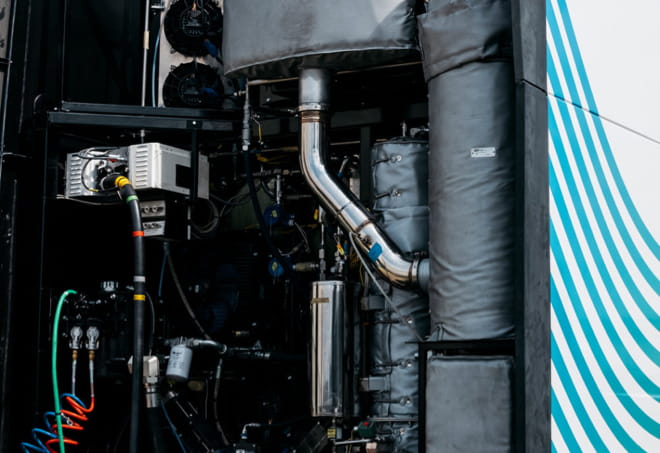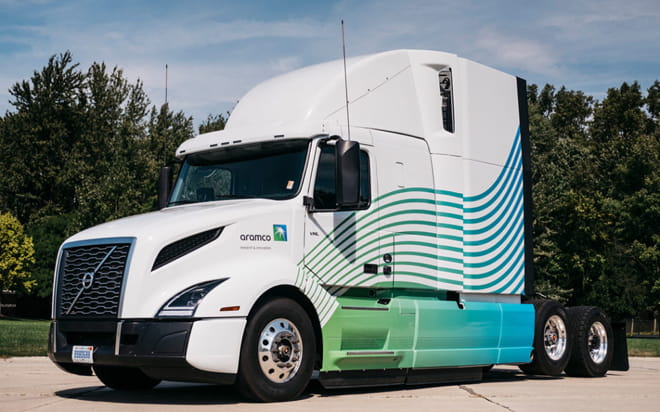
Mobile Carbon Capture
- Our technology has the potential to provide lower-carbon transport for everyone
- We began working on mobile carbon capture in 2010
- Capturing the CO2 at source to lower engine emissions
- Successfully demonstrated in cars and pickups, being validated in trucks; our next focus will be marine transport
For over 140 years, the internal combustion engine has been the heartbeat of our planet, moving billions of people, goods, and materials across the world in cars, trucks, ships, planes and trains.
Current estimates predict that there will be 1.7 billion vehicles using internal combustion engines by 2040. This clearly poses huge challenges for both our natural resources and the environment—particularly in terms of carbon dioxide (CO2) emissions and impending targets on carbon neutrality.
So how do you develop practical solutions for reducing emissions, at a reasonable cost, and with only minimal impact on vehicle performance?

More efficient engines are just the start
There are several ways to increase the efficiency of a vehicle.
You can reduce its weight, improve the aerodynamics so there is less drag, decrease engine friction, and so on. Each of these can make a difference, but our ambition was to take a much larger leap forwards in terms of CO2 reduction.
An idea takes shape
The technology to capture CO2 at source has existed for a while in industrial settings such as power plants. However, capturing it on the move poses a range of complex challenges; from the physical confinements and relative lack of space on board a vehicle, through to dealing with external influences such as variable air flows as it moves.
An added complication is how to generate the additional energy needed to separate the CO2 from the other exhaust gases. Especially as burning extra fuel would cost the driver more money, and would in turn emit more CO2.


One solution lies in reusing existing "waste" energy
Engines typically convert between 25-40% of the energy in the fuel into propulsion. The rest is lost as heat through the radiator and exhaust. Our breakthrough was developing an energy recovery system that could take that wasted heat and convert it into energy to power both the CO2 capture and the compressor units.
Our carbon capture system works by taking the exhaust gases and bringing them into contact with a solvent to capture the CO2, emitting nitrogen, water vapour, and any remaining CO2. Then we compress the CO2 and store it safely in a tank on board the vehicle.
The Four Rs
Removing CO2 from the atmosphere is one of the four "Rs" (alongside reducing, reusing and recycling), helping to restore the human-earth balance as part of the circular carbon economy.
Once the CO2 has been captured, it has to be safely unloaded and then moved by truck or pipeline. Depending on the local conditions, it can then be sequestered into the ground, or used in a variety of different commercial and industrial applications.
For instance, we have developed innovative ways to convert CO2 back into fuels using renewable energies, and to help cure cement.

Developing a feasibility prototype
We began in 2010, exploring different approaches to capturing CO2, including: liquid absorption, solid sorbents, cryogenic, membranes and oxy-combustion. For the feasibility prototype we decided to use a solid sorbent which came with some disadvantages in terms of its size and inflexibility. However, in 2011, after a year of development, we successfully integrated our carbon capture system into a Ford F-250 pickup truck, capturing 10% of the CO2 emissions.
Our instincts had been proven correct, and now the challenge was to make the system smaller and more efficient.
The next phase: passenger cars
Perhaps somewhat counter-intuitively, smaller engines are more inefficient than larger ones. They waste more heat, which means more energy is available to capture and compress the CO2.
In 2013, we switched to a liquid solvent (potassium carbonate solution), enabling us to shrink the whole system to just 1/8 of its original size, and integrate the majority of it underneath the chassis of a Toyota Camry. The result was an impressive tripling in performance—capturing 30% of the CO2 emissions while the car was being driven.

Heavy-duty applications
We also realised the potential our mobile carbon capture technology has for the freight industry, especially as trucks usually return to a depot at the end of their journey, which could make unloading the stored CO2 easier.
So in 2019 we began work on integrating it into a class 8 Volvo heavy-duty truck, using the same principles as our passenger car prototype, but with a much larger system integrated between the cab and trailer. We developed a novel solvent system based on amino acids, and used turbo-compounding to recover energy from the engine. The results were our best to date—capturing 40% of the CO2 emissions from the truck.
Reimagining the freight industry
Currently, over a third of all transport CO2 emissions come from road freight.
Imagine if every heavy-duty truck in the world had our mobile carbon capture technology on board. We could reduce CO2 emissions by up to 708 million tons per year—that’s about the same impact as planting 120 billion new trees.

The future — capturing carbon at sea
Marine transportation is estimated to be responsible for 2.1% of all global CO2 emissions. While ships consume thousands of tons more fuel than cars, the science behind the carbon capture technology is the same - it’s all about scale.
The goal of the International Maritime Organization (IMO) is to reduce greenhouse gas emissions by at least 50% by 2050, compared to 2008 levels. And we’ve just started working with our industry partners to explore ways to adapt the technology for deployment on large ships.



